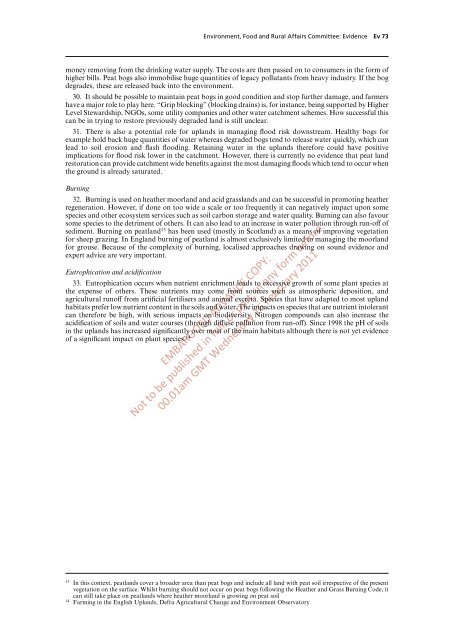Farming in the Uplands - ARCHIVE: Defra
Farming in the Uplands - ARCHIVE: Defra
Farming in the Uplands - ARCHIVE: Defra
You also want an ePaper? Increase the reach of your titles
YUMPU automatically turns print PDFs into web optimized ePapers that Google loves.
Environment, Food and Rural Affairs Committee: Evidence Ev 73<br />
money remov<strong>in</strong>g from <strong>the</strong> dr<strong>in</strong>k<strong>in</strong>g water supply. The costs are <strong>the</strong>n passed on to consumers <strong>in</strong> <strong>the</strong> form of<br />
higher bills. Peat bogs also immobilise huge quantities of legacy pollutants from heavy <strong>in</strong>dustry. If <strong>the</strong> bog<br />
degrades, <strong>the</strong>se are released back <strong>in</strong>to <strong>the</strong> environment.<br />
30. It should be possible to ma<strong>in</strong>ta<strong>in</strong> peat bogs <strong>in</strong> good condition and stop fur<strong>the</strong>r damage, and farmers<br />
have a major role to play here. “Grip block<strong>in</strong>g” (block<strong>in</strong>g dra<strong>in</strong>s) is, for <strong>in</strong>stance, be<strong>in</strong>g supported by Higher<br />
Level Stewardship, NGOs, some utility companies and o<strong>the</strong>r water catchment schemes. How successful this<br />
can be <strong>in</strong> try<strong>in</strong>g to restore previously degraded land is still unclear.<br />
31. There is also a potential role for uplands <strong>in</strong> manag<strong>in</strong>g flood risk downstream. Healthy bogs for<br />
example hold back huge quantities of water whereas degraded bogs tend to release water quickly, which can<br />
lead to soil erosion and flash flood<strong>in</strong>g. Reta<strong>in</strong><strong>in</strong>g water <strong>in</strong> <strong>the</strong> uplands <strong>the</strong>refore could have positive<br />
implications for flood risk lower <strong>in</strong> <strong>the</strong> catchment. However, <strong>the</strong>re is currently no evidence that peat land<br />
restoration can provide catchment wide benefits aga<strong>in</strong>st <strong>the</strong> most damag<strong>in</strong>g floods which tend to occur when<br />
<strong>the</strong> ground is already saturated.<br />
Burn<strong>in</strong>g<br />
32. Burn<strong>in</strong>g is used on hea<strong>the</strong>r moorland and acid grasslands and can be successful <strong>in</strong> promot<strong>in</strong>g hea<strong>the</strong>r<br />
regeneration. However, if done on too wide a scale or too frequently it can negatively impact upon some<br />
species and o<strong>the</strong>r ecosystem services such as soil carbon storage and water quality. Burn<strong>in</strong>g can also favour<br />
some species to <strong>the</strong> detriment of o<strong>the</strong>rs. It can also lead to an <strong>in</strong>crease <strong>in</strong> water pollution through run-oV of<br />
sediment. Burn<strong>in</strong>g on peatland13 has been used (mostly <strong>in</strong> Scotland) as a means of improv<strong>in</strong>g vegetation<br />
for sheep graz<strong>in</strong>g. In England burn<strong>in</strong>g of peatland is almost exclusively limited to manag<strong>in</strong>g <strong>the</strong> moorland<br />
for grouse. Because of <strong>the</strong> complexity of burn<strong>in</strong>g, localised approaches draw<strong>in</strong>g on sound evidence and<br />
expert advice are very important.<br />
Eutrophication and acidification<br />
33. Eutrophication occurs when nutrient enrichment leads to excessive growth of some plant species at<br />
<strong>the</strong> expense of o<strong>the</strong>rs. These nutrients may come from sources such as atmospheric deposition, and<br />
agricultural runoV from artificial fertilisers and animal excreta. Species that have adapted to most upland<br />
habitats prefer low nutrient content <strong>in</strong> <strong>the</strong> soils and water. The impacts on species that are nutrient <strong>in</strong>tolerant<br />
can <strong>the</strong>refore be high, with serious impacts on biodiversity. Nitrogen compounds can also <strong>in</strong>crease <strong>the</strong><br />
acidification of soils and water courses (through diVuse pollution from run-oV). S<strong>in</strong>ce 1998 <strong>the</strong> pH of soils<br />
<strong>in</strong> <strong>the</strong> uplands has <strong>in</strong>creased significantly over most of <strong>the</strong> ma<strong>in</strong> habitats although <strong>the</strong>re is not yet evidence<br />
of a significant impact on plant species. 14<br />
EMBARGOED ADVANCE COPY:<br />
Not to be published <strong>in</strong> full, or part, <strong>in</strong> any form before<br />
00.01am GMT Wednesday 16 February 2011<br />
13 In this context, peatlands cover a broader area than peat bogs and <strong>in</strong>clude all land with peat soil irrespective of <strong>the</strong> present<br />
vegetation on <strong>the</strong> surface. Whilst burn<strong>in</strong>g should not occur on peat bogs follow<strong>in</strong>g <strong>the</strong> Hea<strong>the</strong>r and Grass Burn<strong>in</strong>g Code, it<br />
can still take place on peatlands where hea<strong>the</strong>r moorland is grow<strong>in</strong>g on peat soil<br />
14 <strong>Farm<strong>in</strong>g</strong> <strong>in</strong> <strong>the</strong> English <strong>Uplands</strong>, <strong>Defra</strong> Agricultural Change and Environment Observatory

















